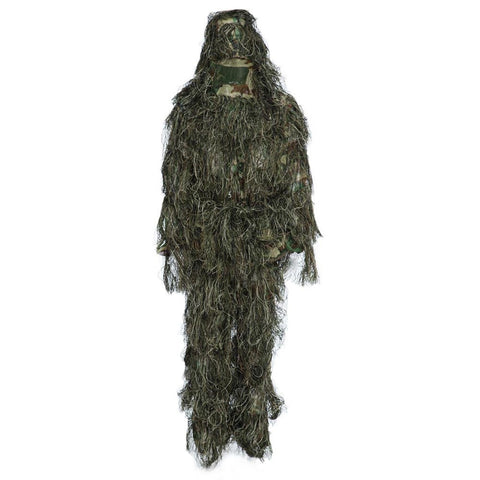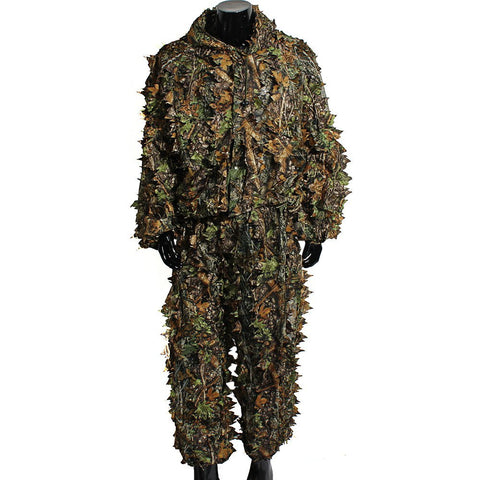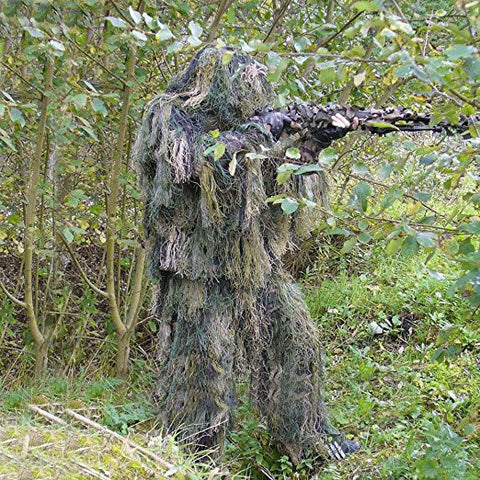You’ll have no doubt seen snipers featured in films or on the news, you might have even seen the uncanny looking half man half bush hybrid making an appearance. The weird looking human can owe his look to the ghillie suit. Gillie suits are designed to allow a sniper blend into the environment, so much so that you’d be hard pushed to spot one in the wild.
Top Ghillie Suite's
Dark Green Woodsman Bio Ghillie Suit
Light Green Woodsman Bio Ghillie Suit
Jungle Camo Huntsman Camo Ghillie Suit
Helikon Camouflage Ghillie Suit Digital Woodland
The word ghillie originates from Scotland, where it was used to describe a type of game warden. A ghillie would be responsible for guarding the game on the land they were employed to protect. Occasionally a ghillie would be tasked with capturing a deer alive, which they would accomplish by lying perfectly still in wait for hours until a deer to approach. Once the deer was within range, the ghillie would break from cover and wrestle the deer until it was under control. The poor deer could then be returned to lords keep, where it could be shot in relative comfort in a pretend hunt.
A modern day ghillie suit is essentially a specialised military uniform which has been modified to meet a snipers specific needs. The underside of the ghillie suite is often reinforced, waterproofed and padded in order to maximise the comfort of the sniper tasked with lying in the same spot for hours or even days. Camouflaged netting can be applied to the suit, which can then have shredded burlap or other similar materials applied. Ghillie suits are most often coloured to match the surrounding environment. Additional elements such as branches, vines, twigs, sticks and grass can also be incorporated into the netting to further enhance the camouflage and obfuscate the wearers outline.
It’s very rare to encounter a straight line in nature, so the standard equipment given to soldiers, such as antennas and rifles often stands out and give away the position of an otherwise camouflaged soldier. To combat this, snipers may apply ghillie suit methods of concealment to their weapons, wrapping rifles in canvas and adding pieces of cloth to break up the outline of the gun.
A soldier is trained to be aware of unusual or out of place things in their surroundings that could signify a risk or threat. Humans are one of the most recognisable outlines in nature. Spotters and snipers are all taught to look for colour and contours when attempting to spot potential threats in the terrain. A ghillie suit attempts to combat this by breaking up the easily recognisable human outline, allowing for the wearer to blend seamlessly with the surrounding flora. “With a good ghillie suit,” Army Ranger Sniper explains, “you could hide in a yard and people wouldn’t be able to see you.”
Ghillie suits first appeared in the early 20th century. A visionary officer in the Scottish army named Lord Lovat used two specialist companies of solider in 1899 in South Africa. He picked out soldiers from the highlands that had ghillie experience, reasoning that their existing wilderness skills could be supplemented by additional training to create a formidable force. These men were tasked with reconnaissance and scouting during the Boers war.
Lord Lovats scouts soon proved their worth in the field, significantly improving the intelligence gathered by utilising their ability to stay hidden close to the enemy for days at a time. The Lovat scouts continued to be used in the way during WWI and WWII. Around 1916, an elite contingent of the Lovats scouts was turned into a sniper unit. This unit was distinguished in its ability to gather intelligence and single out and pick off commanding officers within the enemy troops. The unit proved to be so successful that the British army attempted to provision every battalion with their own contingent of Lovat Scout snipers. The scouts proved to be a critical component of the reconnaissance of enemy positions, resulting in more effective offensive strikes against the opposition army.
Today, the methods and tactics employed by the Lovat scouts have evolved are widely adopted by armies around the world. The legacy of the Scottish ghillies lives on in the ghillie suit.
source https://www.bladespro.co.uk/blogs/news/six-of-the-best-ghillie-suites-available







No comments:
Post a Comment